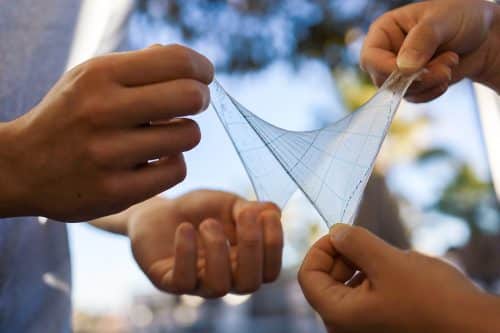Skin-like integrated circuits that can be stretched and be returned to their original form.
Researchers from Stanford University have developed skin-like integrated circuits that can be stretched, folded, bent, twisted without damaging their operating capability. Just like elastic rubber, the stretchable circuits can return to their original shape every time they are stretched.
Recently published in a new study, Zhenan Bao, a chemical engineer, and her colleagues explain the invention in more detail. Bao, who has been working on this development for over two decades describes the major hurdle being the commercialisation of the materials. “How does one produce a completely new technology in quantities great enough to make commercialization possible?” Bao said.

Bao and her team believe they have found a solution to this. They have printed – stretchable, rubbery- skin-like materials that can be used in integrated circuits. To implement this, the group used the same equipment that is conventionally being used for making solid silicon chips. The team was able to fit over 40,000 transistors in a single square centimetre of stretchable material. The team believes that this number can double in subsequent studies.
Though the number of transistors is nowhere comparable to the present onboard numbers, the use case of this flexible circuit is immense such as in bio-electronics applications like Implantable in implantable devices. The team believes their flexible material would contain enough transistors to create simple circuits that can perform functions such as on-skin sensors.
Photolithography
The method used by the team is called photolithography, an already existing method inside foundries that uses ultraviolet lights to transfer a detailed electrically active geometric pattern onto a solid substrate layer by layer. Using this, they were able to enhance the elastic-transistor density by up to 100 times. Being a more cost-effective method, they believe that stretchable circuits can be produced at less cost than rigid ones.
“Our method improves elastic-transistor density by more than 100 times what anyone else has achieved so far. And it does it with excellent uniformity in the transistors while sacrificing nothing in electronic or mechanical performance,” said postdoctoral researcher Yu-Qing Zheng, co-first author of the paper.
The newly produced flexible circuits delivered roughly the same electrical performance as transistors used for current computer displays and the materials showed high durability and performance. According to the team, the streatchable circuits showed no cracks, delimitation or even loss of functioning even after 1,000 repeated stretches.
“With improvements in transistor density, this process could lead to new applications for flexible circuitry,” said postdoctoral fellow Donglai Zhong, a co-first author on the study.






